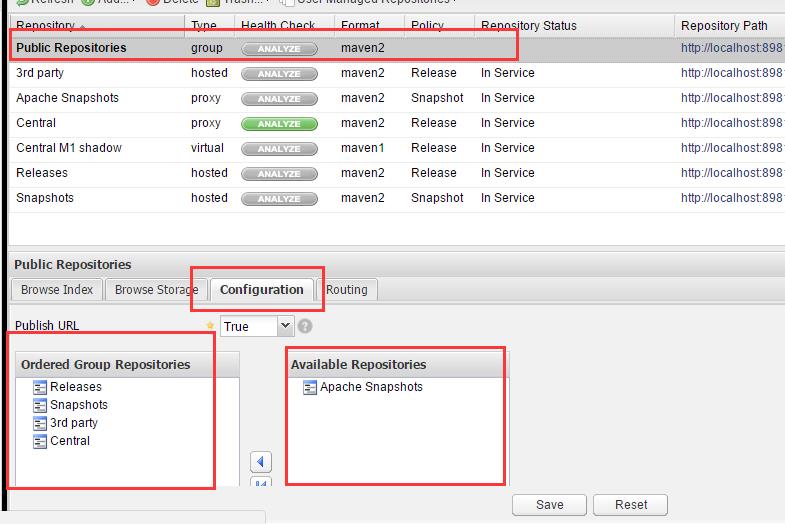如何为 Maven 私服 nexus 设置代理上网
Posted
tags:
篇首语:本文由小常识网(cha138.com)小编为大家整理,主要介绍了如何为 Maven 私服 nexus 设置代理上网相关的知识,希望对你有一定的参考价值。
如果只是想同一时间只用一台电脑上网的话:拉好网线新建 “网络连接”就可以了
网络连接的建立方法:
1.在桌面“右键”-“网上邻居”,选择菜单中的“属性”
2.在网络连接的窗口右边栏中“单键”-“创建一个新的连接”
3.在“新建连接向导”中选择“下一步”
选择“连接到Internet”-“下一步”
选择“手动设置我的连接”-“下一步”
选择“用要求用户名和密码的宽带连接来连接”-“下一步”
填入“ISP名称”(ISP名称是这个连接的名,什么名都可以)-“下一步”
填入宽带帐号密码再“下一步”就可以完成 参考技术A 代理培训就可以
maven私服搭建nexus介绍
1.各个仓库介绍

Hosted:宿主仓库
主要放本公司开发的SNAPSHOTS测试版本,RELEASES正式发行版。合作公司第三方的jar包。
Proxy:代理仓库
代理中央仓库;代理Apache下测试版本jar包
Group:组仓库
存放各种仓库(宿主仓库,代理仓库)
Virtual:虚拟仓库(废弃)
代理maven1版本的jar包
2.组仓库可进行配置,存放那个仓库(配置后 通过组仓库即可访问配置过的仓库)

3.maven中私服的配置
jar包上传配置
setting.xml中的配置
<server> <!-- 发布的位置在POM中配置,以ID为关联,有很多公用的信息需要配置在POM文件里,最佳实践是定义一个公司级别的root pom --> <id>releases</id> <username>admin</username> <password>admin123</password> </server> <server> <id>snapshots</id> <username>admin</username> <password>admin123</password> </server> 项目pom.xml配置 <!-- 分配 --> <distributionManagement> <repository> <id>releases</id> <url>http://localhost:8081/nexus/content/repositories/releases/</url> </repository> <snapshotRepository> <id>snapshots</id> <url>http://localhost:8081/nexus/content/repositories/snapshots/</url> </snapshotRepository> </distributionManagement>
4.jar包下载配置
setting.xml配置
<!-- 自定义本地仓库地址,其默认值为~/.m2/repository <localRepository>/data/maven-repository</localRepository> --> <!-- 发布的服务器和密码,暂时未限制权限 --> <servers> <server> <!-- 发布的位置在POM中配置,以ID为关联,有很多公用的信息需要配置在POM文件里,最佳实践是定义一个公司级别的root pom --> <id>nexus</id> <username>admin</username> <password>admin123</password> </server> <server> <id>nexus-snapshots</id> <username>admin</username> <password>admin123</password> </server> <server> <id>thirdparty</id> <username>admin</username> <password>admin123</password> </server> </servers>
<!-- 配置镜像 --> <mirrors> <mirror> <!-- 此镜像一般用来作为公司内部开发的版本快照,作为public-snapshots仓库的镜像地址 --> <!-- 镜像的id,id用来区分不同的mirror元素。 --> <id>nexus-public-snapshots</id> <!-- 被镜像的服务器的id。例如,如果我们要设置了一个Maven中央仓库(http://repo1.maven.org/maven2)的镜像, 就需要将该元素设置成central。这必须和中央仓库的id “central”完全一致。 --> <mirrorOf>public-snapshots</mirrorOf> <!-- 该镜像的URL。 --> <url>http://192.168.10.92:8081/nexus/content/groups/public-snapshots</url> </mirror> <mirror> <!-- 此镜像一般用来作为公司第三方引用基础类库镜像,是所有仓库的镜像地址 --> <id>nexus</id> <!-- 为*表示为所有的仓库做镜像,有了这个配置,所有的构建都会包含public组,如果你想包含public-snapshots组, 你必须添加public-snapshots这个Profile,通过在命令行使用如下的 -P 标志:$ mvn -P public-snapshots clean install --> <mirrorOf>*</mirrorOf> <url>http://192.168.10.92:8081/nexus/content/groups/public</url> </mirror> </mirrors> <!-- settings.xml中的profile元素是pom.xml中profile元素的裁剪版本。它包含了activation, repositories, pluginRepositories 和 properties元素。 这里的profile元素只包含这四个子元素是因为这里只关心构建系统这个整体(这正是settings.xml文件的角色定位),而非单独的项目对象模型设置。 如果一个settings中的profile被激活,它的值会覆盖任何其它定义在POM中或者profile.xml中的带有相同id的profile。 --> <profiles> <profile> <id>development</id> <!-- 仓库。仓库是Maven用来填充构建系统本地仓库所使用的一组远程项目。而Maven是从本地仓库中使用其插件和依赖。 不同的远程仓库可能含有不同的项目,而在某个激活的profile下,可能定义了一些仓库来搜索需要的发布版或快照版构件。有了Nexus,这些应该交由Nexus完成 --> <repositories> <repository> <id>central</id> <!-- 虚拟的URL形式,指向镜像的URL,因为所有的镜像都是用的是nexus,这里的central实际上指向的是http://repos.d.xxx.com/nexus/content/groups/public --> <url>http://central</url> <!-- 表示可以从这个仓库下载releases版本的构件--> <releases><enabled>true</enabled></releases> <!-- 表示可以从这个仓库下载snapshot版本的构件 --> <snapshots><enabled>true</enabled></snapshots> </repository> </repositories> <!-- 插件仓库。仓库是两种主要构件的家。第一种构件被用作其它构件的依赖。这是中央仓库中存储大部分构件类型。 另外一种构件类型是插件。Maven插件是一种特殊类型的构件。由于这个原因,插件仓库独立于其它仓库。 pluginRepositories元素的结构和repositories元素的结构类似。每个pluginRepository元素指定一个Maven可以用来寻找新插件的远程地址。 --> <pluginRepositories> <pluginRepository> <id>central</id> <url>http://central</url> <releases><enabled>true</enabled></releases> <snapshots><enabled>true</enabled></snapshots> </pluginRepository> </pluginRepositories> </profile> <profile> <!--this profile will allow snapshots to be searched when activated--> <id>public-snapshots</id> <repositories> <repository> <id>public-snapshots</id> <!-- 虚拟的URL形式,指向镜像的URL,这里指向的是http://repos.d.xxx.com/nexus/content/groups/public-snapshots --> <url>http://public-snapshots</url> <releases><enabled>false</enabled></releases> <snapshots><enabled>true</enabled></snapshots> </repository> </repositories> <pluginRepositories> <pluginRepository> <id>public-snapshots</id> <url>http://public-snapshots</url> <releases><enabled>false</enabled></releases> <snapshots><enabled>true</enabled></snapshots> </pluginRepository> </pluginRepositories> </profile> </profiles> <!-- 激活的Profile。activation元素并不是激活profile的唯一方式。settings.xml文件中的activeProfile元素可以包含profile的id, 任何在activeProfile中定义的profile id,不论环境设置如何,其对应的profile都会被激活。如果没有匹配的profile,则什么都不会发生。 profile也可以通过在命令行,使用-P标记和逗号分隔的列表来显式的激活(如,-P test)。 要了解在某个特定的构建中哪些profile会激活,可以使用maven-help-plugin(mvn help:active-profiles)。 --> <activeProfiles> <!-- 没有显示激活public-snapshots --> <activeProfile>development</activeProfile> </activeProfiles>
以上是关于如何为 Maven 私服 nexus 设置代理上网的主要内容,如果未能解决你的问题,请参考以下文章